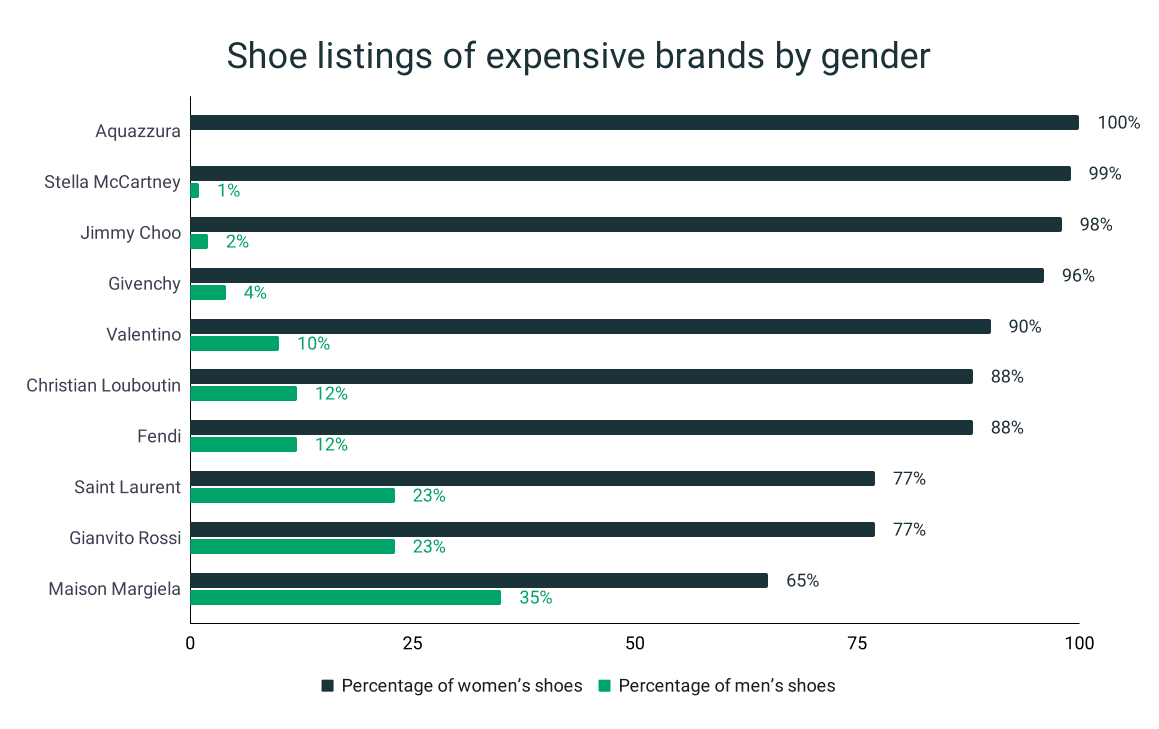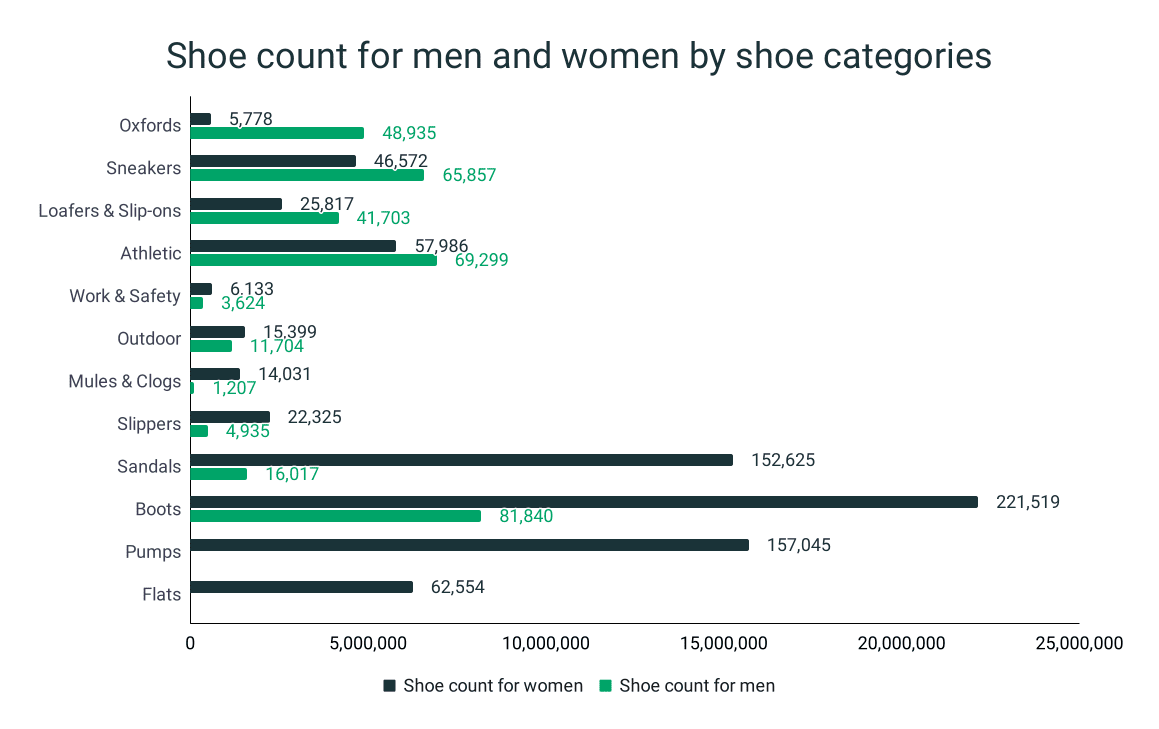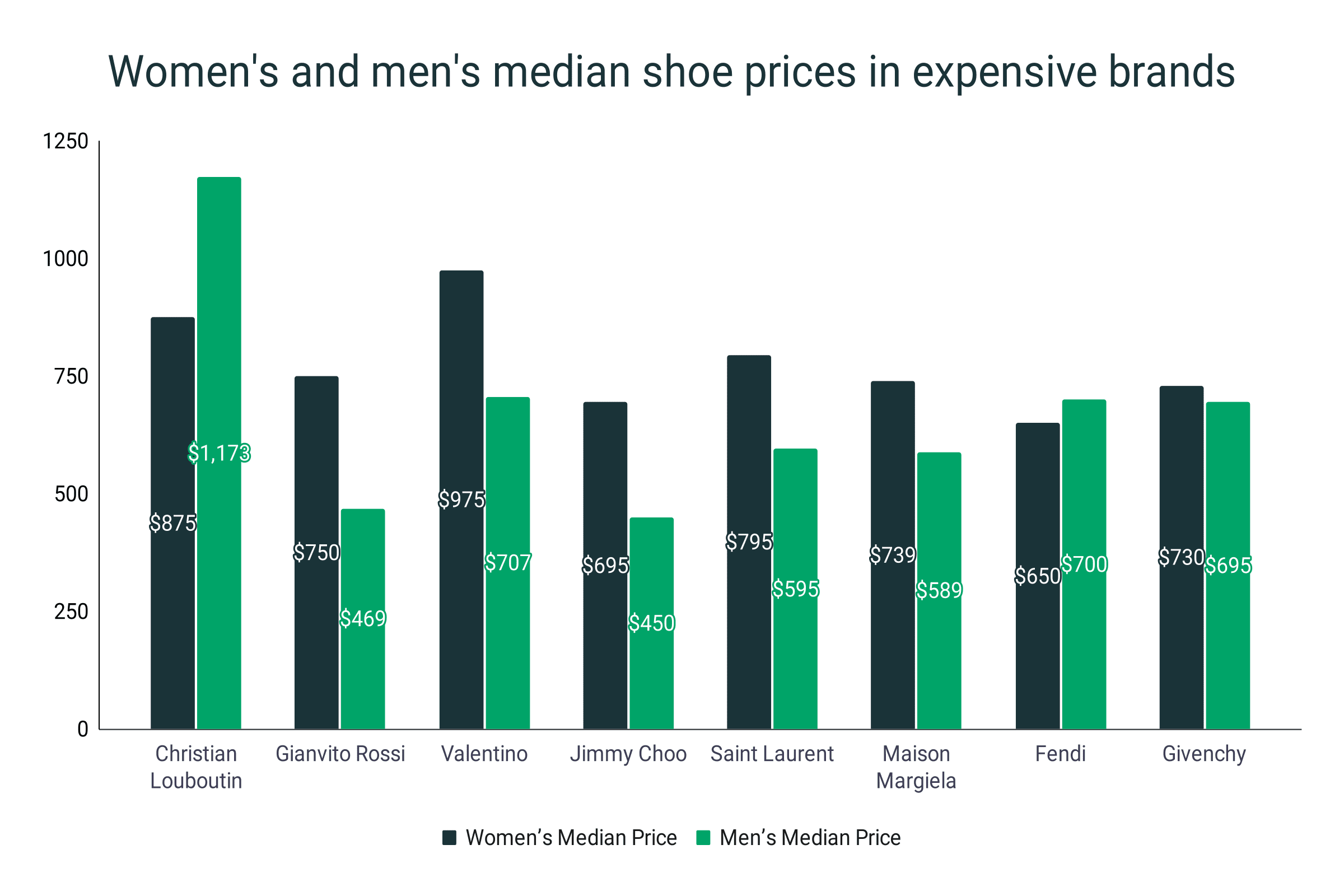Women's Shoe Statistics
Top women’s shoe statistics
- In 2023, the women’s shoe market size is estimated to reach almost $187 billion.
- The forecasted compound annual growth rate of women’s shoe revenue from 2018 to 2027 is 4.2%.
- North America is expected to dominate the 2023 market of women's shoes with a 21.25% share.
- Asia Pacific, on the other hand, is the region foreseen to have the lowest market share of 18.66%.
- The projected market value of women’s luxury shoes in 2023 is $29.10 billion.
- By 2029, the women’s designer shoe market size is anticipated to expand to $39 billion.
- The global revenue of the women’s non-athletic footwear industry in 2023 is estimated at around $128 billion.
- While women in the US own 17 pairs of shoes on average, they only wear 3 pairs regularly.
- Each year, women purchase an average of 3 pairs of shoes and spend $49 a pair.
- The woman who holds the Guinness World Record for having the largest shoe collection is Darlene Flynn with over 16,000 pairs of shoes.
- The average women’s shoe size around the world is 7 to 8.
- In America, the average shoe size for women is 8.5 to 9.
- 63% of shoes are for women, while 5.6% are for girls.
- Women have 148% more boots brands to choose from than men.
- Women also have 168% more clogs and 128% more slippers to choose from than men.
- Jimmy Choo, a famous expensive brand, offers 99% of its shoes to women.
- However, women’s shoes from Jimmy Choo are also more expensive than men’s by a median price difference of $245.
- Nike only offers 34% of shoes to women.
- The median price difference between Nike’s men's and women's offerings is only $5, with men’s pairs as the more expensive.
- 60% of women in the US are willing to continue wearing uncomfortable shoes for fashion.
- More than 50% of women worldwide would rather be barefoot than tolerate painful shoes.
- 50% of women’s shoe purchases are done solely because of their desire to buy, and not because they need to.
- 19% of women buy shoes to satisfy their happiness.
Global women’s shoe market size
- The projected market value of women’s shoes in 2023 is $186.86 billion.
- In 2022, the market size reached a revenue of $179.33 billion.
- The value of the women’s shoe market in 2021 was $172.10 billion.
- Women’s shoe market size in 2019 gained $158.51 billion.
- In 2018, the market’s worth was valued at around $152.12 billion.
- From 2018 to 2027, the women’s shoe industry is anticipated to increase at a compound annual growth rate of 4.2%.
- By 2027, the size of the women’s shoes global revenue is expected to grow to approximately $220 billion.
|
Year |
Market value (in billions) |
|
2018 |
$152.12 |
|
2019 |
$158.51 |
|
2020 |
$165.17 |
|
2021 |
$172.10 |
|
2022 |
$179.33 |
|
2023 |
$186.86 |
|
2024 |
$194.71 |
|
2025 |
$202.88 |
|
2026 |
$211.41 |
|
2027 |
$219.54 |
Women’s luxury shoe global market
- The women’s luxury shoe worldwide market is anticipated to expand to $29.10 billion in 2023.
- The industry of women’s luxury footwear reached a revenue of nearly $28 billion in 2022.
- The market size of women’s high-end shoes is expected to rise at a compound annual growth rate of 5% from 2022 to 2029.
- Accordingly, the market size is estimated to be worth $39 billion by 2029.
|
Year |
Market value (in billions) |
|
2022 |
$27.72 |
|
2023 |
$29.10 |
|
2024 |
$30.56 |
|
2025 |
$32.09 |
|
2026 |
$33.69 |
|
2027 |
$35.37 |
|
2028 |
$37.14 |
|
2029 |
$39.00 |
Global market size of women’s non-athletic shoes
- The overall revenue of women’s non-athletic footwear is estimated to be worth $128.12 billion in 2023.
- From 2023 up to 2028, the global women’s non-athletic shoe market is expected to expand at a compound annual growth rate of 3.68%.
- Consequently, by 2028, the forecasted market value is about $153.5 billion.
|
Year |
Market value (in billions) |
|
2023 |
$128.12 |
|
2024 |
$132.83 |
|
2025 |
$137.72 |
|
2026 |
$142.79 |
|
2027 |
$148.05 |
|
2028 |
$153.49 |

How many shoes does an average woman have?
- American ladies possess an average of 17 pairs of shoes.
- However, only 3 pairs are worn regularly.
- 50% of women own over 10 pairs and 13% of women have more than 30 pairs but only 39% consider themselves as a “shoe person.”
- Every 1 out of 12 women owns 100 or over than a hundred pairs of shoes.
- On average, women purchase about 3 pairs per year and spend $49 per pair.
- For every 7 ladies, 1 admits to keeping at least one of their purchases a secret from their partners.
Women’s average shoe size
- The global average shoe size for adult women is 7 to 8.
- In the US, the average shoe size of women is 8.5 to 9.
- The typical shoe size of women in the UK is 6.5 or 7.
- Australian ladies have an average shoe size of 7.5 while most Japanese adult women fit 5.5 shoes.
- Adult women aged 20 and above and heights between 4’9” and 5’3” have an average shoe size of 5 to 8.5.
- 5’4” to 5’7” ladies usually have shoe sizes from 6.5 to 10.
- Taller adult women with height that ranges from 5’6” to 6” have an average shoe size of 9 to 15.
- Pregnancy, especially for first-time mothers, can decrease feet arches, and consequently increase foot length by 0.1 up to 0.4 inches.
|
Country |
Average shoe size (US size) |
|
The United States |
8.5 to 9 |
|
The United Kingdom |
6.5 to 7 |
|
Japan |
5.5 |
|
Australia |
7.5 |
|
Height |
Average shoe size (US size) |
|
4’9” to 5’3” |
5 to 8.5 |
|
5’4” to 5’7” |
6.5 to 10 |
|
5’6” to 6’ or taller |
9 to 15 |
Women vs. men shoe statistics
- With 63% of shoes intended for women, they have the most pairs to choose from.
- Women are followed by girls with the most shoe selections as 5.6% of shoes are offered to them.
- As of 2017, there are around 1,060 brands that sell women's shoes.
- Compared to men, women have more than 87% more brands to choose from.
- It is estimated that women spend double as much as men when purchasing shoes.
Brand count by shoe categories
- 7 out of 12 shoe categories are offered by more brands to women than men.
- There are around 25% more brands that sell athletic footwear to ladies than gents.
- Women have 568% and 142% more brands to choose sandals and slippers from compared to men.
- 163% more brands have women’s boots than men’s boots.
- Men lead in the brand count for oxfords, trainers, and loafers by 495%, 4%, and 10%, respectively than women.
- There are also 46% and 15% more brands that offer outdoor and work shoes to men than to women.
|
Shoe category |
Brand count for women |
Brand count for men |
|
Oxfords |
22 |
131 |
|
Trainers |
166 |
172 |
|
Loafers & Slip-ons |
105 |
116 |
|
Athletic |
144 |
115 |
|
Work & Safety |
34 |
39 |
|
Outdoor |
41 |
60 |
|
Mules & Clogs |
68 |
20 |
|
Slippers |
58 |
24 |
|
Sandals |
474 |
71 |
|
Boots |
500 |
190 |
|
Pumps |
340 |
0 |
|
Flats |
199 |
0 |
Shoe count by shoe categories
- There are 8 out of 12 shoe categories in which women’s shoe count dominates over men’s.
- There are 787,784 shoe counts for women in a total of 12 categories.
- For men, there are only 345,121 shoes offered in 10 categories.
- Compared to men, women have 1062% more clogs and 352% more slippers to select from.
- However, when it comes to oxfords, men have 747% more shoe choices than women.
- Fellas also have 62% more loafers, 41% more trainers, and 20% more athletic footwear to choose from compared to ladies.
|
Shoe category |
Shoe count for women |
Shoe count for men |
|
Oxfords |
5,778 |
48,935 |
|
Trainers |
46,572 |
65,857 |
|
Loafers & Slip-ons |
25,817 |
41,703 |
|
Athletic |
57,986 |
69,299 |
|
Work & Safety |
6,133 |
3,624 |
|
Outdoor |
15,399 |
11,704 |
|
Mules & Clogs |
14,031 |
1,207 |
|
Slippers |
22,325 |
4,935 |
|
Sandals |
152,625 |
16,017 |
|
Boots |
221,519 |
81,840 |
|
Pumps |
157,045 |
0 |
|
Flats |
62,554 |
0 |
Shoe listings of expensive brands by gender
- Aquazzura is a high-end brand with 100% of their shoes marketed and sold to women.
- 99% of the footwear offered by Stella McCartney is for women.
- Jimmy Choo is another designer brand that sells 98% of their shoe models to ladies.
- Givency, with an estimated net worth of almost $65 million, has 96% of its footwear selection intended for women.
- 90% of Valentino’s pairs are available for girls.
- Louboutin and Fendi are expensive brands that both have 88% of their shoe catalogues with ladies as target markets.
|
Brand |
Percentage of women’s shoes |
Percentage of men’s shoes |
|
Aquazzura |
100% |
0% |
|
Stella McCartney |
99% |
1% |
|
Jimmy Choo |
98% |
2% |
|
Givenchy |
96% |
4% |
|
Valentino |
90% |
10% |
|
Christian Louboutin |
88% |
12% |
|
Fendi |
88% |
12% |
|
Saint Laurent |
77% |
23% |
|
Gianvito Rossi |
77% |
23% |
|
Maison Margiela |
65% |
35% |

Women’s vs. men’s median shoe prices for the most expensive brands
- Out of all these 10 brands, only Christian Louboutin offers more expensive shoes to men than women, with a median price difference of $298.
- Women’s shoes from Gianvito Rossi are $281 pricier than their men’s offerings.
- Valentino women’s shoe selection has a median price of $975, while men’s only have a $707 median price.
- Jimmy Choos for men are $245 generally more affordable than their women pairs.
- The difference between the median prices of women’s and men’s pairs from Saint Laurent is $200, with the women’s selection as the more costly.
- Maison Margiela women’s pairs are also more expensive than the men’s pair with a $150 difference.
- The prices of men's and women’s shoes from Fendi and Givenchy are closer to each other with only $50 and $35 deviation.
|
Brand |
Women’s Median Price |
Men’s Median Price |
Difference |
|
Christian Louboutin |
$875 |
$1,173 |
$298 |
|
Gianvito Rossi |
$750 |
$469 |
$281 |
|
Valentino |
$975 |
$707 |
$268 |
|
Jimmy Choo |
$695 |
$450 |
$245 |
|
Saint Laurent |
$795 |
$595 |
$200 |
|
Maison Margiela |
$739 |
$589 |
$150 |
|
Fendi |
$650 |
$700 |
$50 |
|
Givenchy |
$730 |
$695 |
$35 |
Shoe listings of popular brands by gender
- 62% of all the Skechers pairs are intended for women.
- ASICS and Converse are brands that sell 50% of their shoes to women and 50% to men.
- New Balance has 43% of its shoe selections available to women.
- 40% of K-Swiss footwear have women as their target market.
- Women’s shoes cover 36% of the pairs offered by Reebok and PUMA.
- Nike and Vans have more men’s offerings by 66% and 67% compared to women’s.
- Adidas only has 27% of its footwear products catering to women.
|
Brand |
Percentage of women’s shoes |
Percentage of men’s shoes |
|
Skechers |
62% |
38% |
|
ASICS |
50% |
50% |
|
Converse |
50% |
50% |
|
New Balance |
43% |
57% |
|
K-Swiss |
40% |
60% |
|
Reebok |
36% |
64% |
|
PUMA |
36% |
64% |
|
Nike |
34% |
66% |
|
Vans |
33% |
67% |
|
adidas |
27% |
73% |
Women’s vs. men’s median shoe prices for popular brands
Men’s shoes offered by popular brands are generally more high-priced than women’s pairs.
- Vans trainers for men are $10 more costly than women’s kicks.
- The difference between the median prices of men’s and women’s pairs from Skechers is $6, with women’s shoes being cheaper.
- The trainers offered to men by Converse, Nike, and Adidas are all $5 more expensive than pairs for women.
- K-Swiss pairs for ladies are pricier than men but only by $1.
- The median price of the ASICS shoes for men and women are both $70 while for PUMA, both are $50.
|
Brand |
Women’s Median Price |
Men’s Median Price |
Difference |
|
Vans |
$40 |
$50 |
$10 |
|
Skechers |
$45 |
$51 |
$6 |
|
Converse |
$40 |
$45 |
$5 |
|
Nike |
$80 |
$85 |
$5 |
|
adidas |
$70 |
$75 |
$5 |
|
Reebok |
$54 |
$58 |
$4 |
|
New Balance |
$58 |
$61 |
$2 |
|
K-Swiss |
$51 |
$50 |
$1 |
|
ASICS |
$70 |
$70 |
$0 |
|
PUMA |
$50 |
$50 |
$0 |

Which woman owns the most pair of shoes?
- Darlene Flynn holds the record of having the largest shoe collection reaching more than 16,000 pairs.
- With over 10,000 pairs in her closet, Celine Dion is also one of the women who acquired the most pairs.
- Danielle Steel, an American writer, owns at least 6,000 pairs.
- The controversial Imelda Marcos, the wife of the late dictator of the Philippines, Ferdinand Marcos, had more than 3,400 pairs of shoes.
- Paris Hilton has almost 2,000 pairs of shoes.
How many women suffer from painful shoes
- 90% of American women own at least a pair of painful shoes.
- 60% of women are willing to tolerate painful shoes in the name of fashion.
- Almost 60% also got blisters because of shoes.
- 24% of women have fallen because of their shoes.
- Around 33% of women worldwide became unable to walk properly for days because of wearing an incorrect size of shoes.
- Over 80% of American women wear painful pairs at least once per month.
- 41% wear uncomfortable shoes at least four times monthly.
- 40% of women in the US own shoes that are painful to walk in but still decide to wear them.
- 44% of women still proceed wearing shoes that they’re sure will hurt their feet at least twice a month.
- Over half of the women around the world would prefer walking or dancing barefoot than continuing to wear painful shoes.
- 1/3 of the women's global population admits carrying a spare pair of comfortable shoes.
- 35% had their night ruined because of painful shoes while 14% of adult ladies brought their night outs to an early end.
- 32% of women are using shoes that are not their size.
Why women shop for shoes
- Half of the shoe purchases of women derive from wants and not needs.
- 19% of women shop for shoes to make themselves happy.
- 28% of ladies believe that shoes are an essential element of their outfit.
- More than 50% of girls notice shoes that other people are wearing.
Sources
https://www.statista.com/statistics/976217/women-s-footwear-market-size-worldwide/
https://www.databridgemarketresearch.com/reports/global-womens-footwear-market
https://www.mordorintelligence.com/industry-reports/womens-non-athletic-footwear-market
https://shoeaholicsanonymous.com/interesting-shoe-statistics-for-women/
https://www.healthline.com/health/average-shoe-size-for-women#by-country
https://medium.indix.com/shoes-gender-analysis-assortment-for-adults-82207146a622
https://risnews.com/ninety-percent-american-women-own-painful-shoes
https://lahormadetunegocio.com/2022/05/16/consumption-of-footwear-ms-vs-women/






